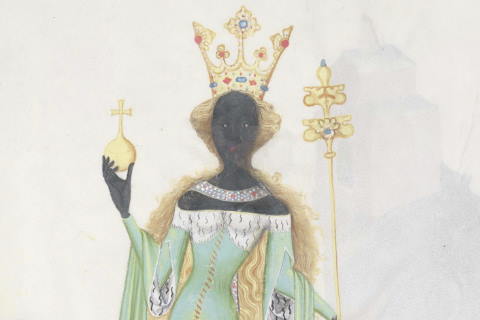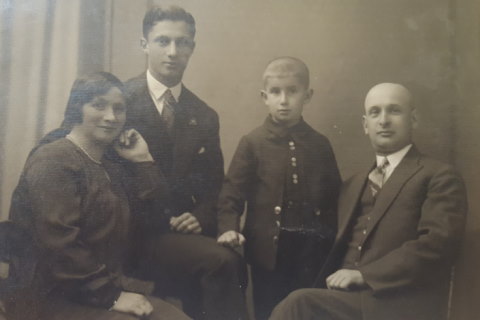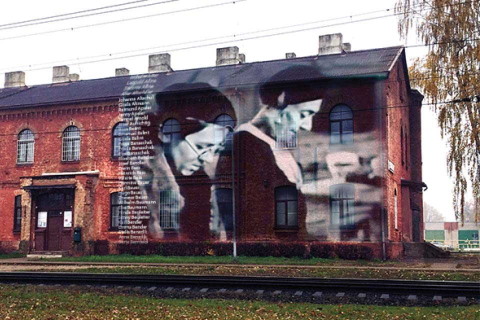The Truth Behind the Notorious Gangster Meyer Lansky: Mensch or Monster?

Lansky as pictured in Lang's graphic novel.
Photo Credit: Illustration by Andrea Mutti and Shawn Martinbrough/Courtesy Jonathan Lang
April 26, 2022
When Jonathan Lang '98 set out to write a graphic novel about the notorious Jewish gangster Meyer Lansky, he was determined to capture the mobster's life in all its moral complexity.
The result is 2019's "Meyer," for which Lang wrote the story and text (illustrations by Andrea Mutti and Shawn Martinbrough), a fictionalized account of Lansky's last days hiding out in a Miami nursing home in the 1980s.
In the book, Lansky has one last caper to commit, and while it leads to plenty of murder and mayhem, it also exposes his menschy side – his connection to his Judaism, devotion to his grandfather and support of Israel.
"In my version, Meyer was a businessman and proud Jew," Lang said. "My Meyer is kind of a Jewish geriatric hero."
Lansky's Life
Born Maier Suchowljansky in 1902 in what is now Belarus, Lansky and his family fled antisemitism in 1911, landing on the Lower East Side of Manhattan. He got involved initially with bootlegging and small-time gambling, but then rose through the ranks to become known as "Mob's Accountant," running casinos and nightclubs for organized crime in Las Vegas, Cuba and Florida.
Lang sees Lansky's career choice as very much the result of antisemitism in America at the time. Lang himself had relatives in Brooklyn in the 1940s who worked as numbers runners.
"Lansky didn't accept the terms life offered him. He took what he wanted," Lang said. "It wasn't a matter of morality. It was a matter of survival."
Lang said it remains unknown to what extent Lansky participated in the violence committed by some of his best-known associates such as "Bugsy" Siegel and "Lucky" Luciano.
The FBI portrayed him as the financial brains behind the mob's operations — "he would have been chairman of the board of General Motors if he'd gone into legitimate business,'' an agent once said — but even that is uncertain. A 1991 biography portrayed him as a failed businessman who bungled the mob's casino operations in Cuba.
In 1970, Lansky was indicted for tax evasion. He fled to Israel but was refused the right to settle there. It was a devastating blow to the mobster, who had always hoped to be buried beside his beloved grandfather on the Mount of Olives in Jerusalem.
Lansky was eventually acquitted of some of the charges against him while others were dropped, partly because he was in ill health. He lived quietly in Miami until his death in 1983.
Lang Learns About Lansky
Lang's fascination with Lansky goes back to his childhood, when his father, a neurosurgeon, saw the gangster in the hallway of a Florida hospital.
Lang's father described Lansky, who was 5-feet 4-inches tall, as "this well-dressed little pisher" [Yiddish for a presumptuous person]. Lansky had the whole hospital hustling around to help him, radiating a presence that commanded respect. "My father said he never saw anything like it," Lang said.
Lang said he had his own rebellious streak while growing up. He hung out with troublemakers and nearly got kicked out of Alexander Muss High School in Tel Aviv, which offers American students a year abroad in Israel.
"Kindness toward my bubbie [Yiddish for grandmother], performing tikkun olam [repairing the world] and still cutting class were exactly who I was," he said. "I straddled the line, at times."
After getting his master's in film at the University of Amsterdam in 2000, Lang moved back to Florida, living in his childhood bedroom, surrounded by his baby pictures and bar mitzvah mementos.
Depressed, he sought comfort and refuge at the local library.
It was kismet that he picked up "Bloodletters and Badmen: A Narrative Encyclopedia of American Criminals from the Pilgrims to the Present," a book he remembered using to write a report about Al Capone in the sixth grade. Thumbing through the book, he found the picture that would launch his novel.
A dapper Meyer, wearing sunglasses, was walking his little dog Bruiser in Miami Beach, looking over his shoulder. The FBI had taken the picture. "When was Lansky in Miami? Who was he watching out for?" Lang wondered.
Lang also thought back to his time at Brandeis when he volunteered as a companion to the elderly at a local retirement home. There, he met Fred Flagg, an amazing 103-year-old member of the first graduating class at Tufts Medical School.
They got together once a week, and Lang would sit and soak up his beguiling stories. "What if my community service was with a gangster?" Lang thought to himself, and that gave him the idea of setting his book in a nursing home.
Lang also read about how Lansky secretly worked with the U.S. Navy during World War II to spot German U-boats along the New York City docks he controlled. "This is a man who was both needed and prosecuted by the same government. How do you reconcile that?" Lang asked.
Lang Meets Lansky II
In another instance of kismet, Lang was busy promoting his book on Instagram last fall. While checking his direct messages, he saw one that stopped him cold. "This is Meyer Lansky. I need to talk to you about your book," it read.
Terrified, Lang says his first thought was, "Is this his ghost?" After a quick search, he realized it was his grandson, Meyer Lansky II.
Lang called Lansky II, and the two hit it off. Lansky II liked the book so much that he offered to write a blurb endorsing it.
Lang and Lansky II are now discussing a synagogue tour and other appearances.
"What a bizarre turn," Lang said. "An imaginary biography led to a relationship with walking history."



